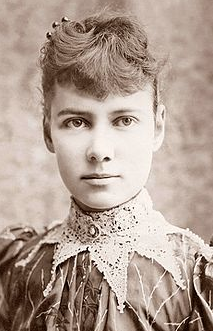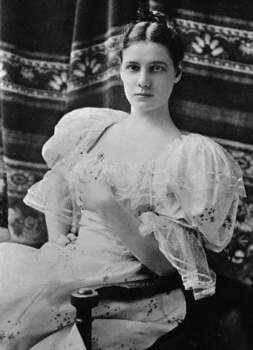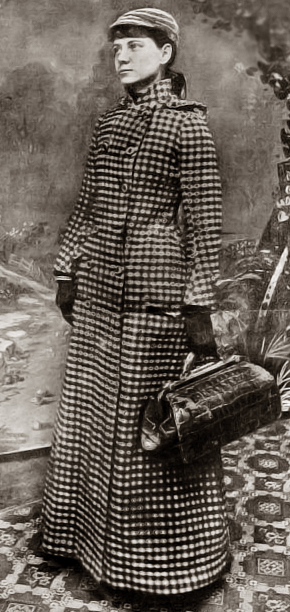Nellie Bly

(Elizabeth Jane Cochran, from Pittsburgh).
Thursday is what passes for my biggest business day of the week, and to my mild surprise, I got through it again. Then I ran a couple errands that had been nagging since the weekend, and took myself off the clock sometime after three. I unloaded the groceries and bundled up the plastic bags and had the place looking squared-away again about halfway through Sheppard Smith’s news show on Fox. I am increasingly thinking he is a Democrat, not that there is anything wrong with it, but along the way, there was a brief mention of Nellie Bly’s trip around the world in 72 days.
As an autodidact (I think we all share that weakness) I am used to running across things I did not know but probably should have. Shep did the “On This Day” bit late in his show to commemorate the 1890s-era exploits of a mad woman who set out to beat the ’80 days’ that writer Jules Verne thought would be a breakneck pace of a trip around the world.
It caught me up short. Great Aunt Eleanor was from Martinsburg, West By God. She was always called “Bly” in the family. She was an imperious woman of immense age to me as a kid. I had no idea why they called her Bly until Shep blindsided me yesterday.
Growing up, I always thought is was weird to have an old lady whose nickname was derived from that of the Captain of HMS Bounty. But it was family stuff and why ask questions. She was a woman of her era. I did not want to be perceived as a potential mutineer.
Lord, I have some stories about her time and passing, and how I wound up with so much of her stuff in the barn at Refuge Farm. The silver and her husband the Doctor’s two hammerless .32 caliber Smith & Wesson pistols are only the tip of the familial iceberg. Apparently the Doctor’s office had been ripped off for the medication he stocked, and did not like it one bit and was prepared to shot the malefactor if he came back. The hammerless feature of the pistols means you can shoot through the fabric of your coat, should that be necessary, as I understand it.
But back to Shep: Eleanor. Nellie. Bly. It only hit me yesterday with a story about the round-the-world lady, Nellie Bly. Oh, shoot, that is what that was about. Great Aunt Eleanor had been a wild woman in her time, and not the frail old woman I knew as a kid.
I did the initial cursory research and was stunned by the real story, which was that of an amazing woman’s adventures In a suffragette-era world. She was, by turns, Reporter. Investigative Journalist. Adventurer. She once spent ten days in a nuthouse to expose the abuses perpetrated on the inmates; she spent six months in Mexico covering the border crisis, married well and converted her fame into comfort. Amelia Ehrhart was of the same cut- being ‘the first’ was a powerful thing. But it took guts and did not always work out well.
At birth, the real Nellie Bly was named Elizabeth Jane Cochran, from “Cochran’s Mills,” now part of the sprawl (limited by the terrain) of the greater Pittsburg area. But there was much more to her than just adventuring.
In my mom’s girlhood recollection, the only thing better than a trip to cosmopolitan Wheeling, WV, was an excursion to the Steel City. The girl who would become ‘Nellie Bly” was moved by her mom (and a large family, ten kids, a number so vast that we moderns can’t imagine it) into Pittsburgh proper. Years later, young Elizabeth read a Pittsburgh Dispatch newspaper column entitled “What Girls Are Good For” that implied that girls were only good for birthing children and keeping house.
That pissed her off, and she wrote a response to the editor under the pseudonym “Lonely Orphan Girl,” arguing that the column was a crock. The Dispatch editor was impressed with her passion and offered her the opportunity to write a piece for the newspaper, again under the pseudonym “Lonely Orphan Girl”.
Her first article was titled “The Girl Puzzle,” and dealt with a too-familiar subject to her, which was the issue of how divorce affects women.
I have some experience with how it affects men these days, but the Patriarchy was in full flower in 1880 and modern legal sensibilities has not yet been installed. Nellie got a full-time job out of it. In those days, it was customary for female newspaper writers to use nom de plumes. I suppose it was for modesty concerns. The editor chose “Nellie Bly,” adopted from the character in the popular song by Stephen Foster. Elizabeth had intended that her pseudonym be “Nelly Bly”, but her editor wrote “Nellie” by mistake and the error stuck.
Not a great deal stuck with her after that. She focused her work in Pittsburgh on telling the tales of the lives of working women, which as you might imagine sort of sucked. The paper got a lot of flack from local industrial concerns, and she was relegated to covering fashion, society and gardening in what was then known as The Woman’s Section. It made her seethe, and she quit to try her luck as a foreign correspondent.

(Nellie Bly in Mexico.)
She spent nearly half a year reporting the lives and customs of the Mexican people, and her social justice dispatches later were published in the book “Six Months in Mexico.” I read that, and thought of the idealistic fervor of the Abraham Lincoln Brigade in Spain a couple decades later. Nellie Bly was something- but it was not until she had been back in New York that the opportunity presented itself to make her a star.
French master author Jules Verne had penned “Around the World in 80 days” (Le tour du monde en quatre-vingts jours) in 1873. The premise of the story was that English eccentric (do I repeat myself?) Phileas Fogg accepts a wager of $20,000 pounds to travel all the way around the world in that number of days, and much entertainment ensues.
The tale might be the best in Verne’s repertoire, but it was not for a couple decades that some public engagement officer cooked up the idea of a lady making her way all the way around on her own and beating the 80 days. Working for the New York World In 1888, Nellie had suggested to her editor that she take a trip around the world, attempting to turn Verne’s fictional account into fact and actually beat it. The paper liked it but waffled. Finally a decision was made, and a year later, at 9:40 a.m. on November 14, 1889, and with two days’ notice, Nellie boarded a steamer of the Hamburg American Line and set out for the east that would become west before she was done with it.
Screen Shot 2018-01-26 at 12.07.44 PM.png
She took with her the dress she was wearing, a sturdy overcoat, several changes of underwear, and a small travel bag carrying her toiletry essentials.
I invite you to read the tale of that journey by steamer, railroad, rickshaw and elephant at the Smithsonian’s fine appreciation:
https://www.smithsonianmag.com/smart-news/nellie-blys-record-breaking-trip-around-world-was-to-her-surprise-race-180957910/
So, whether I like Sheppard Smith and his snarky attitude, I have to express some heartfelt thanks. He directed me to a story of an extraordinary woman. He also explained something about my family I had not known, and moreover about some of the crap in the barn at the farm. Wish I had known to ask, back when there was time.

Great Aunt Eleanor must have been hell on wheels if they called her Nellie Bly.
Copyright 2018 Vic Socotra
www.vicsocotra.com
